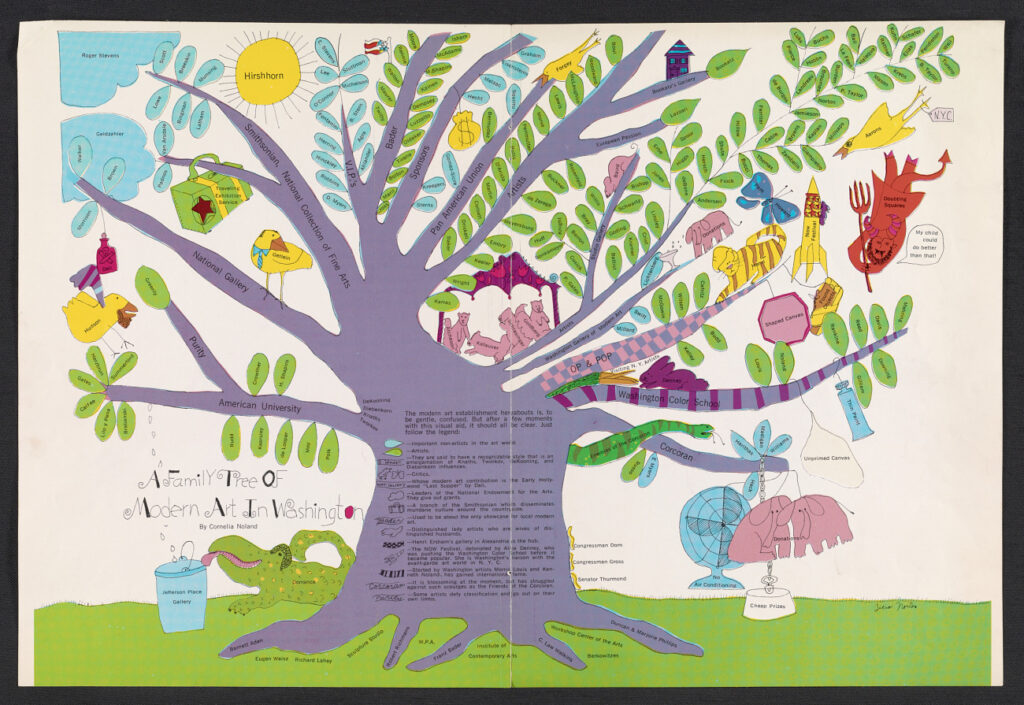
While researching the Pan American Union in the Archives of American Art, I stumbled across this two page spread from the 1960s, “A Family Tree of Modern Art in Washington, by Cornelia Noland.” It is a little snarky, a little petty, but quite revealing? “The modern art establishment here is, to be gentle, confused,” Noland wrote.
The most highly developed critique is probably of the Corcoran: “It is blossoming at the moment, but has struggled against such scourges as the Friends of the Corcoran.” The Corcoran’s branch, meanwhile, is wrapped by a snake labeled, “Enemies of the Corcoran,” and is being pulled down by a fan [“no air conditioning”], a weight [“cheap prizes”] and two pink elephants [“donations.”]
The strongest, or thickest, branch of artists is labeled “American University,” whose artists all have a “recognizable style” derived from the likes of DeKooning and Tworkov. The most elaborate, predictably, the Washington Color School, does place Morris Louis and [Cornelia’s ex] Kenneth Noland nearest the trunk.
The mention of the NEA and the appearance of NEA artist grant distributor Henry Geldzahler in a cloud of money means it’s no earlier than 1966. From this 2022 citation from Cornelia’s son William, we learn the family tree was published in the February 1967 issue of Washingtonian Magazine. From digitized correspondence with the Phillipses it sounds like she began covering art for the magazine in 1965.
In his extraordinary 2019 Artforum article on Cady Noland’s family tree, Bruce Hainley described her mother Cornelia as “a student and ally of Morris Louis.” From the letter to the editor she wrote in 1971, calling out his attempt to insert himself into the founding of the Washington Color School, Cornelia could also be called, “a merciless factchecking nemesis of Gene Davis.”
Fascinated with photography since her childhood in the 1930s, Cornelia created a vast archive of vernacular and found photographs, which William, a photographer himself, describes on his own website:
In short order Cornelia amassed a wide array of formal and informal images, generally paying only modest sums. Her omnivorous eye for the ironic and bizarre took center stage as she dwelled on the foibles of human behavior. She seemed to intuitively align with Roland Barthes’s notion of punctum, the “sensory, intensely subjective effect of a photograph on a viewer”, as the scholar Séamus Kealy so neatly put it. She amassed a wide array of images that delivered just such an effect, and her New York City apartment became crowded with her expanding collection. Her eye skewed heavily towards subjects who were far from ordinary, opting for x-rays of character that highlighted the bizarre and ironic, most often finding her way to individuals who were flawed, eccentric, sometimes violent or kinky. At first, Cornelia curated groups of images in loosely themed three-ring binders. Over time, however, the binders multiplied and most often ended up fat and overflowing, with juxtaposed images made into splashy chapters that were ordered by increasingly subtle and nuanced themes.
William has rephotographed and reworked photos from Cornelia’s collection into his own series of digital collages titled, Images of Images. While Cornelia showed her own artwork very early on, in a Clement Greenberg-curated group show Hainley cited, for example, I think I speak for the entire world when I say, let’s see the photos.
Hainley recounts that a couple of months after Cady’s first show at White Columns, in 1988, Cornelia Noland Reis [she remarried in 1985] was in a New York Times report about parents criticizing an Upper West Side ‘psychotherapy cult’ collective that cut off contact with family members, including both adult children and minors. Kenneth was one of several artists critic Robert Hughes associated with the cult.
Some of these tabs had been open in my browser for months. When I found the tree, I thought, oh, just do one more quick search before posting. Which is how I found an obituary dated January 19, announcing Cornelia Noland Reis passed away in late December 2024. Peace to her family and friends.
